Exploring Human Impact and Sustainability in Environmental Science
VerifiedAdded on 2023/05/31
|12
|3465
|107
Homework Assignment
AI Summary
This assignment delves into the multifaceted aspects of environmental science, beginning with a comparison of highly developed, moderately developed, and less developed countries in terms of per capita income and resource consumption. It distinguishes between people overpopulation and consumption overpopulation, highlighting their respective impacts on the environment. The assignment further explores the key factors determining human impact, including population size, affluence, and technology, and emphasizes the importance of environmental sustainability by addressing human behaviors that threaten it. It also outlines the scientific method and problem-solving stages in environmental contexts. Furthermore, the assignment discusses sustainable development, complexities of sustainable consumption, environmental ethics, and environmental justice, relating poverty and population growth to carrying capacity. Finally, it covers environmental history, politics, economics, risk analysis, and environmental health hazards, offering a comprehensive overview of crucial environmental issues and solutions. Desklib provides access to similar assignments and study tools for students.
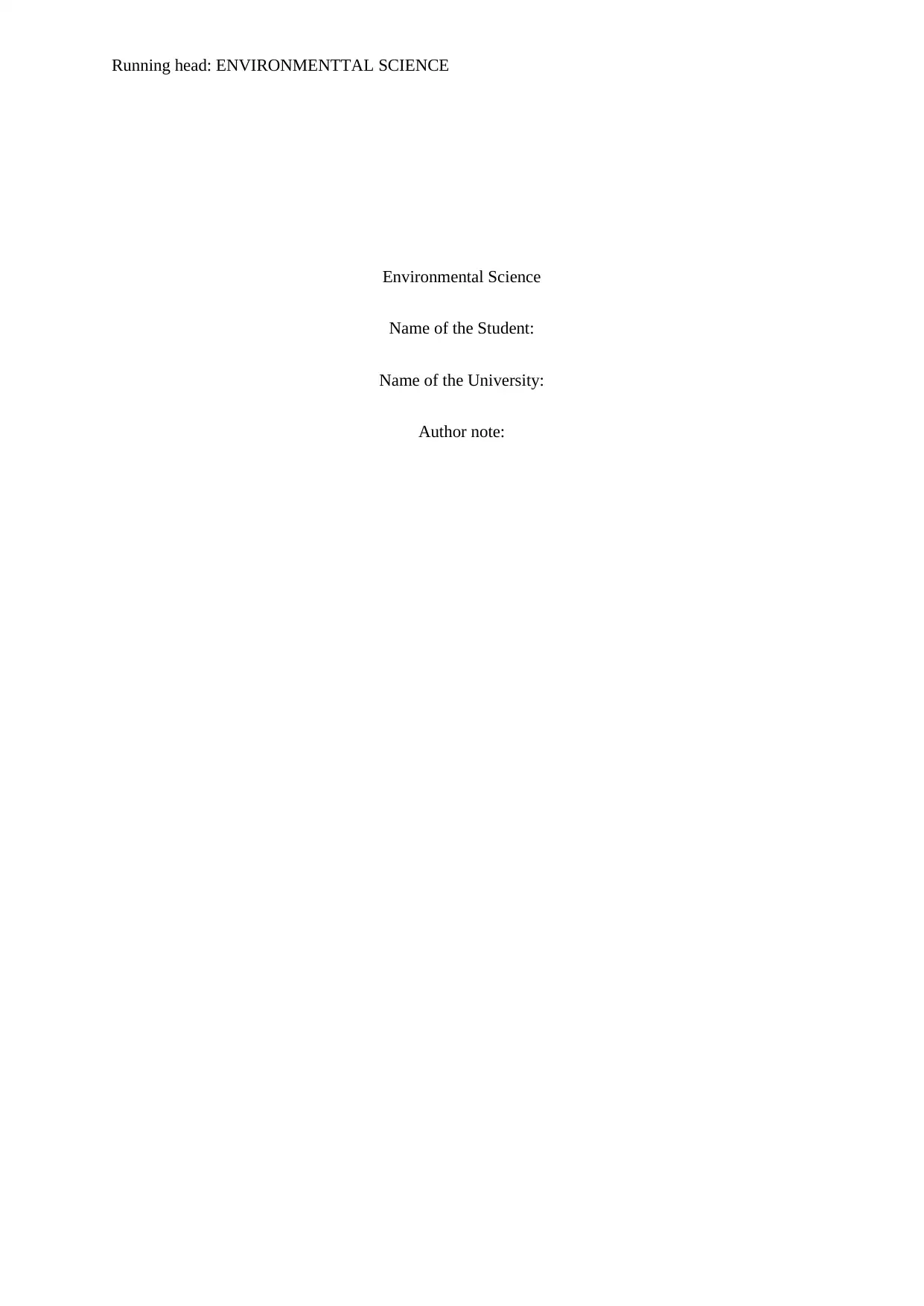
Running head: ENVIRONMENTTAL SCIENCE
Environmental Science
Name of the Student:
Name of the University:
Author note:
Environmental Science
Name of the Student:
Name of the University:
Author note:
Secure Best Marks with AI Grader
Need help grading? Try our AI Grader for instant feedback on your assignments.
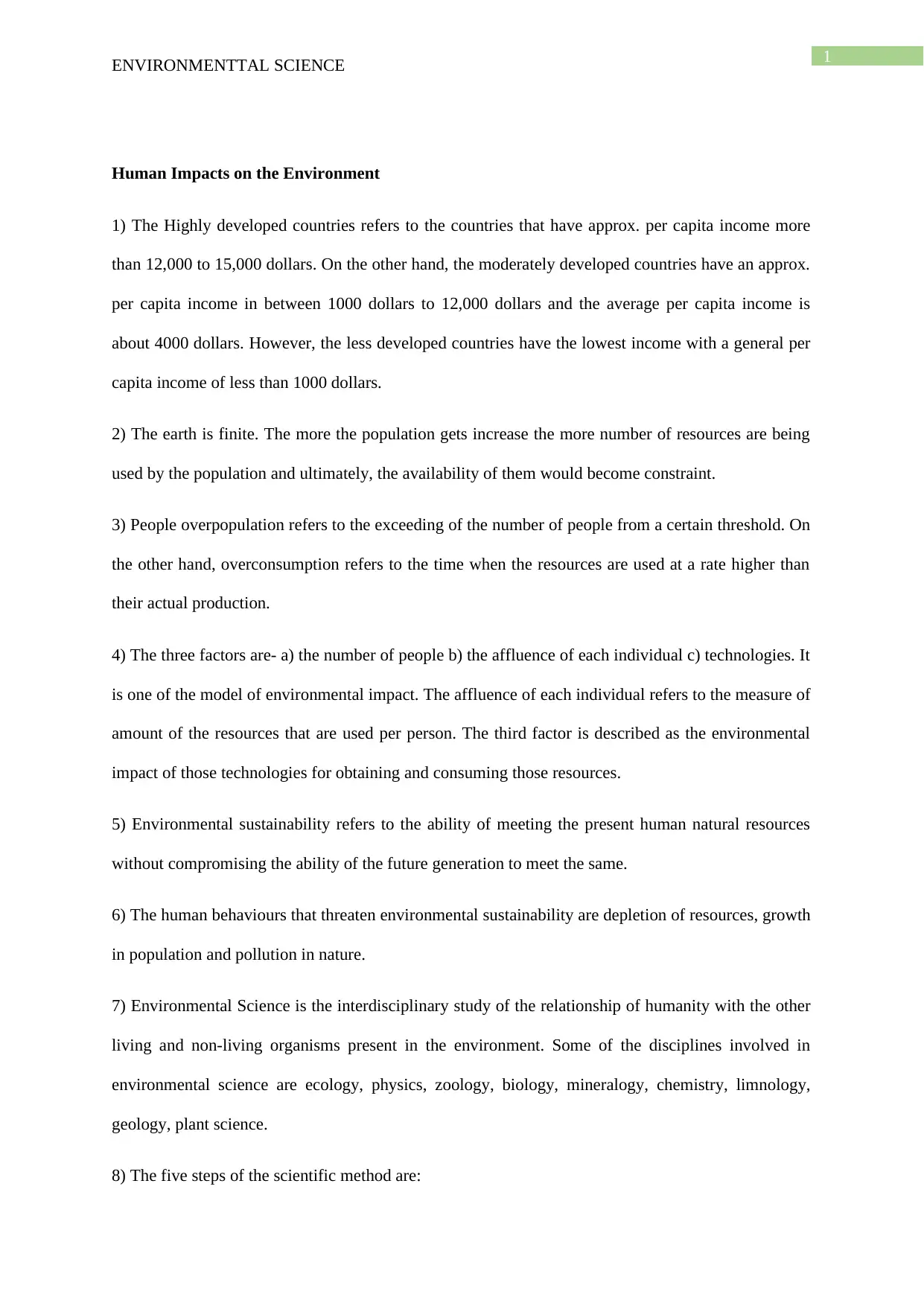
1
ENVIRONMENTTAL SCIENCE
Human Impacts on the Environment
1) The Highly developed countries refers to the countries that have approx. per capita income more
than 12,000 to 15,000 dollars. On the other hand, the moderately developed countries have an approx.
per capita income in between 1000 dollars to 12,000 dollars and the average per capita income is
about 4000 dollars. However, the less developed countries have the lowest income with a general per
capita income of less than 1000 dollars.
2) The earth is finite. The more the population gets increase the more number of resources are being
used by the population and ultimately, the availability of them would become constraint.
3) People overpopulation refers to the exceeding of the number of people from a certain threshold. On
the other hand, overconsumption refers to the time when the resources are used at a rate higher than
their actual production.
4) The three factors are- a) the number of people b) the affluence of each individual c) technologies. It
is one of the model of environmental impact. The affluence of each individual refers to the measure of
amount of the resources that are used per person. The third factor is described as the environmental
impact of those technologies for obtaining and consuming those resources.
5) Environmental sustainability refers to the ability of meeting the present human natural resources
without compromising the ability of the future generation to meet the same.
6) The human behaviours that threaten environmental sustainability are depletion of resources, growth
in population and pollution in nature.
7) Environmental Science is the interdisciplinary study of the relationship of humanity with the other
living and non-living organisms present in the environment. Some of the disciplines involved in
environmental science are ecology, physics, zoology, biology, mineralogy, chemistry, limnology,
geology, plant science.
8) The five steps of the scientific method are:
ENVIRONMENTTAL SCIENCE
Human Impacts on the Environment
1) The Highly developed countries refers to the countries that have approx. per capita income more
than 12,000 to 15,000 dollars. On the other hand, the moderately developed countries have an approx.
per capita income in between 1000 dollars to 12,000 dollars and the average per capita income is
about 4000 dollars. However, the less developed countries have the lowest income with a general per
capita income of less than 1000 dollars.
2) The earth is finite. The more the population gets increase the more number of resources are being
used by the population and ultimately, the availability of them would become constraint.
3) People overpopulation refers to the exceeding of the number of people from a certain threshold. On
the other hand, overconsumption refers to the time when the resources are used at a rate higher than
their actual production.
4) The three factors are- a) the number of people b) the affluence of each individual c) technologies. It
is one of the model of environmental impact. The affluence of each individual refers to the measure of
amount of the resources that are used per person. The third factor is described as the environmental
impact of those technologies for obtaining and consuming those resources.
5) Environmental sustainability refers to the ability of meeting the present human natural resources
without compromising the ability of the future generation to meet the same.
6) The human behaviours that threaten environmental sustainability are depletion of resources, growth
in population and pollution in nature.
7) Environmental Science is the interdisciplinary study of the relationship of humanity with the other
living and non-living organisms present in the environment. Some of the disciplines involved in
environmental science are ecology, physics, zoology, biology, mineralogy, chemistry, limnology,
geology, plant science.
8) The five steps of the scientific method are:
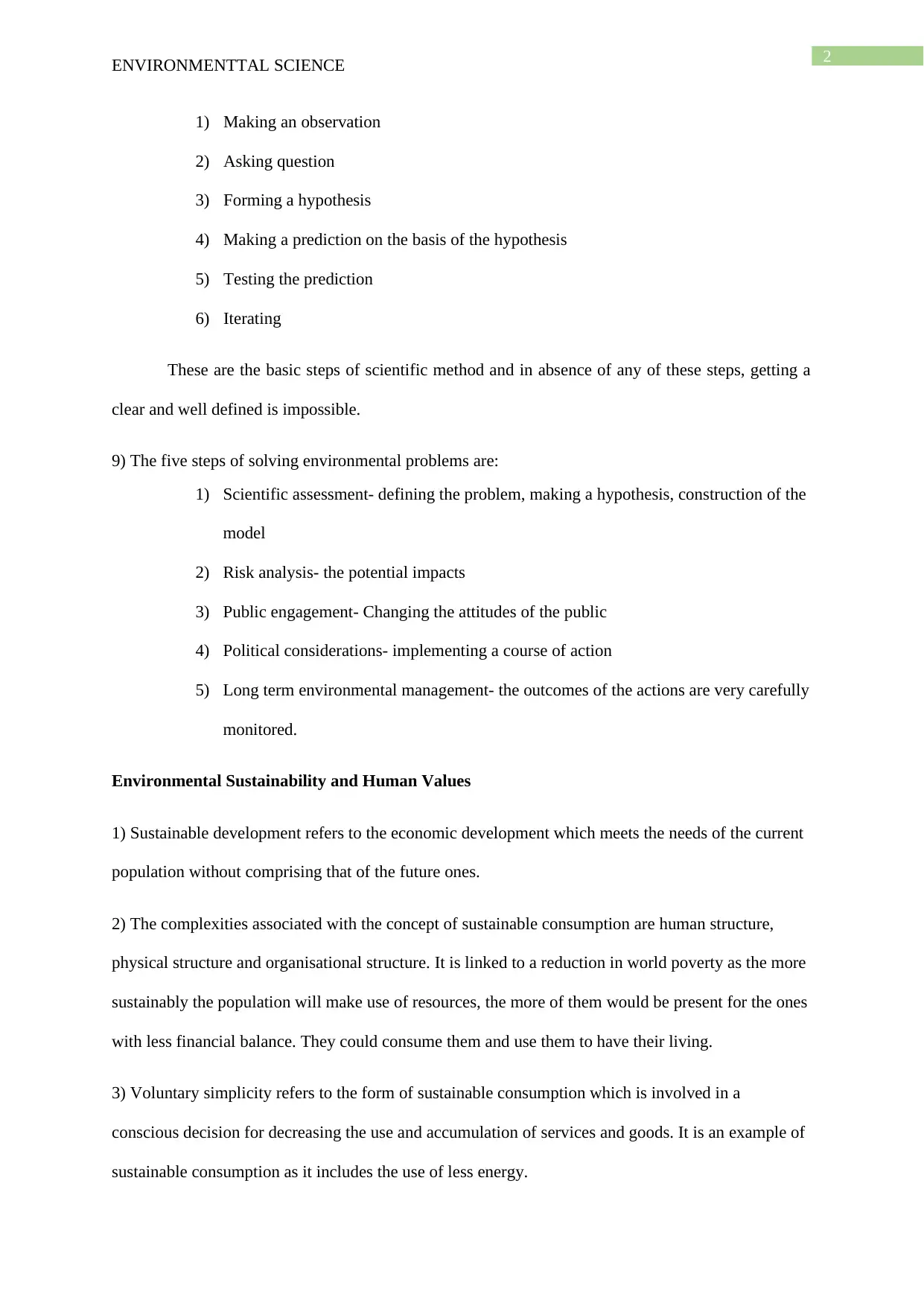
2
ENVIRONMENTTAL SCIENCE
1) Making an observation
2) Asking question
3) Forming a hypothesis
4) Making a prediction on the basis of the hypothesis
5) Testing the prediction
6) Iterating
These are the basic steps of scientific method and in absence of any of these steps, getting a
clear and well defined is impossible.
9) The five steps of solving environmental problems are:
1) Scientific assessment- defining the problem, making a hypothesis, construction of the
model
2) Risk analysis- the potential impacts
3) Public engagement- Changing the attitudes of the public
4) Political considerations- implementing a course of action
5) Long term environmental management- the outcomes of the actions are very carefully
monitored.
Environmental Sustainability and Human Values
1) Sustainable development refers to the economic development which meets the needs of the current
population without comprising that of the future ones.
2) The complexities associated with the concept of sustainable consumption are human structure,
physical structure and organisational structure. It is linked to a reduction in world poverty as the more
sustainably the population will make use of resources, the more of them would be present for the ones
with less financial balance. They could consume them and use them to have their living.
3) Voluntary simplicity refers to the form of sustainable consumption which is involved in a
conscious decision for decreasing the use and accumulation of services and goods. It is an example of
sustainable consumption as it includes the use of less energy.
ENVIRONMENTTAL SCIENCE
1) Making an observation
2) Asking question
3) Forming a hypothesis
4) Making a prediction on the basis of the hypothesis
5) Testing the prediction
6) Iterating
These are the basic steps of scientific method and in absence of any of these steps, getting a
clear and well defined is impossible.
9) The five steps of solving environmental problems are:
1) Scientific assessment- defining the problem, making a hypothesis, construction of the
model
2) Risk analysis- the potential impacts
3) Public engagement- Changing the attitudes of the public
4) Political considerations- implementing a course of action
5) Long term environmental management- the outcomes of the actions are very carefully
monitored.
Environmental Sustainability and Human Values
1) Sustainable development refers to the economic development which meets the needs of the current
population without comprising that of the future ones.
2) The complexities associated with the concept of sustainable consumption are human structure,
physical structure and organisational structure. It is linked to a reduction in world poverty as the more
sustainably the population will make use of resources, the more of them would be present for the ones
with less financial balance. They could consume them and use them to have their living.
3) Voluntary simplicity refers to the form of sustainable consumption which is involved in a
conscious decision for decreasing the use and accumulation of services and goods. It is an example of
sustainable consumption as it includes the use of less energy.
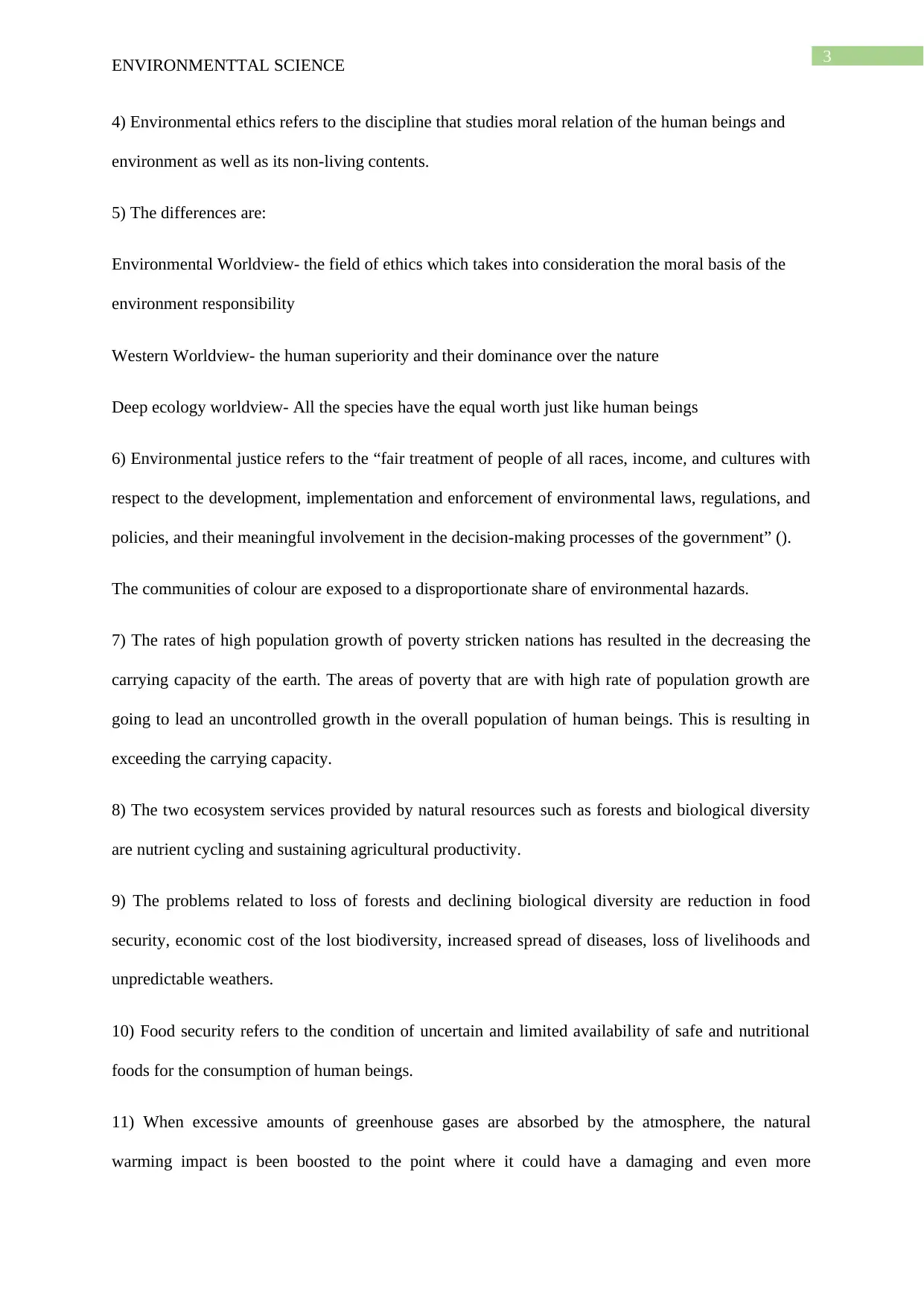
3
ENVIRONMENTTAL SCIENCE
4) Environmental ethics refers to the discipline that studies moral relation of the human beings and
environment as well as its non-living contents.
5) The differences are:
Environmental Worldview- the field of ethics which takes into consideration the moral basis of the
environment responsibility
Western Worldview- the human superiority and their dominance over the nature
Deep ecology worldview- All the species have the equal worth just like human beings
6) Environmental justice refers to the “fair treatment of people of all races, income, and cultures with
respect to the development, implementation and enforcement of environmental laws, regulations, and
policies, and their meaningful involvement in the decision-making processes of the government” ().
The communities of colour are exposed to a disproportionate share of environmental hazards.
7) The rates of high population growth of poverty stricken nations has resulted in the decreasing the
carrying capacity of the earth. The areas of poverty that are with high rate of population growth are
going to lead an uncontrolled growth in the overall population of human beings. This is resulting in
exceeding the carrying capacity.
8) The two ecosystem services provided by natural resources such as forests and biological diversity
are nutrient cycling and sustaining agricultural productivity.
9) The problems related to loss of forests and declining biological diversity are reduction in food
security, economic cost of the lost biodiversity, increased spread of diseases, loss of livelihoods and
unpredictable weathers.
10) Food security refers to the condition of uncertain and limited availability of safe and nutritional
foods for the consumption of human beings.
11) When excessive amounts of greenhouse gases are absorbed by the atmosphere, the natural
warming impact is been boosted to the point where it could have a damaging and even more
ENVIRONMENTTAL SCIENCE
4) Environmental ethics refers to the discipline that studies moral relation of the human beings and
environment as well as its non-living contents.
5) The differences are:
Environmental Worldview- the field of ethics which takes into consideration the moral basis of the
environment responsibility
Western Worldview- the human superiority and their dominance over the nature
Deep ecology worldview- All the species have the equal worth just like human beings
6) Environmental justice refers to the “fair treatment of people of all races, income, and cultures with
respect to the development, implementation and enforcement of environmental laws, regulations, and
policies, and their meaningful involvement in the decision-making processes of the government” ().
The communities of colour are exposed to a disproportionate share of environmental hazards.
7) The rates of high population growth of poverty stricken nations has resulted in the decreasing the
carrying capacity of the earth. The areas of poverty that are with high rate of population growth are
going to lead an uncontrolled growth in the overall population of human beings. This is resulting in
exceeding the carrying capacity.
8) The two ecosystem services provided by natural resources such as forests and biological diversity
are nutrient cycling and sustaining agricultural productivity.
9) The problems related to loss of forests and declining biological diversity are reduction in food
security, economic cost of the lost biodiversity, increased spread of diseases, loss of livelihoods and
unpredictable weathers.
10) Food security refers to the condition of uncertain and limited availability of safe and nutritional
foods for the consumption of human beings.
11) When excessive amounts of greenhouse gases are absorbed by the atmosphere, the natural
warming impact is been boosted to the point where it could have a damaging and even more
Secure Best Marks with AI Grader
Need help grading? Try our AI Grader for instant feedback on your assignments.
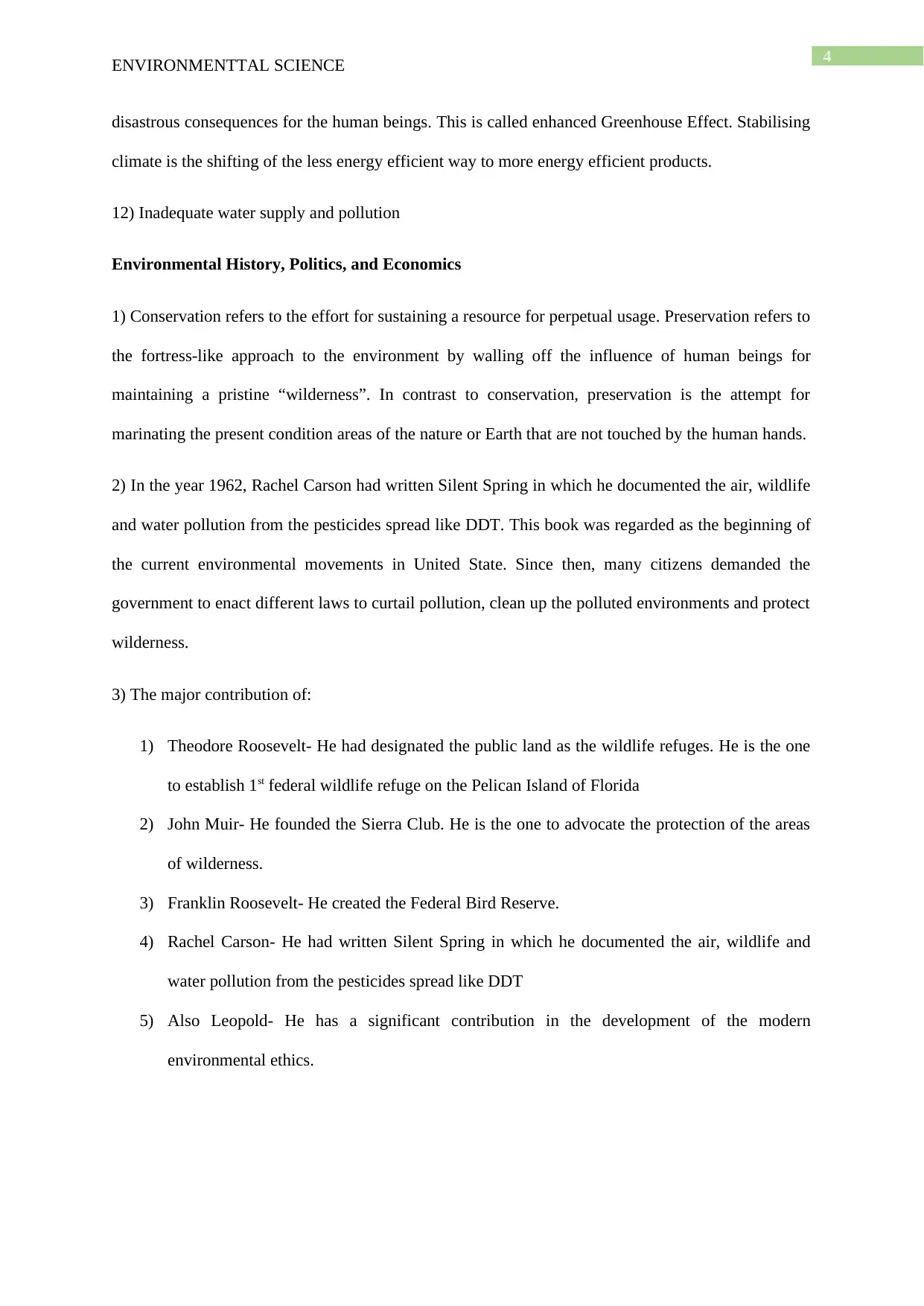
4
ENVIRONMENTTAL SCIENCE
disastrous consequences for the human beings. This is called enhanced Greenhouse Effect. Stabilising
climate is the shifting of the less energy efficient way to more energy efficient products.
12) Inadequate water supply and pollution
Environmental History, Politics, and Economics
1) Conservation refers to the effort for sustaining a resource for perpetual usage. Preservation refers to
the fortress-like approach to the environment by walling off the influence of human beings for
maintaining a pristine “wilderness”. In contrast to conservation, preservation is the attempt for
marinating the present condition areas of the nature or Earth that are not touched by the human hands.
2) In the year 1962, Rachel Carson had written Silent Spring in which he documented the air, wildlife
and water pollution from the pesticides spread like DDT. This book was regarded as the beginning of
the current environmental movements in United State. Since then, many citizens demanded the
government to enact different laws to curtail pollution, clean up the polluted environments and protect
wilderness.
3) The major contribution of:
1) Theodore Roosevelt- He had designated the public land as the wildlife refuges. He is the one
to establish 1st federal wildlife refuge on the Pelican Island of Florida
2) John Muir- He founded the Sierra Club. He is the one to advocate the protection of the areas
of wilderness.
3) Franklin Roosevelt- He created the Federal Bird Reserve.
4) Rachel Carson- He had written Silent Spring in which he documented the air, wildlife and
water pollution from the pesticides spread like DDT
5) Also Leopold- He has a significant contribution in the development of the modern
environmental ethics.
ENVIRONMENTTAL SCIENCE
disastrous consequences for the human beings. This is called enhanced Greenhouse Effect. Stabilising
climate is the shifting of the less energy efficient way to more energy efficient products.
12) Inadequate water supply and pollution
Environmental History, Politics, and Economics
1) Conservation refers to the effort for sustaining a resource for perpetual usage. Preservation refers to
the fortress-like approach to the environment by walling off the influence of human beings for
maintaining a pristine “wilderness”. In contrast to conservation, preservation is the attempt for
marinating the present condition areas of the nature or Earth that are not touched by the human hands.
2) In the year 1962, Rachel Carson had written Silent Spring in which he documented the air, wildlife
and water pollution from the pesticides spread like DDT. This book was regarded as the beginning of
the current environmental movements in United State. Since then, many citizens demanded the
government to enact different laws to curtail pollution, clean up the polluted environments and protect
wilderness.
3) The major contribution of:
1) Theodore Roosevelt- He had designated the public land as the wildlife refuges. He is the one
to establish 1st federal wildlife refuge on the Pelican Island of Florida
2) John Muir- He founded the Sierra Club. He is the one to advocate the protection of the areas
of wilderness.
3) Franklin Roosevelt- He created the Federal Bird Reserve.
4) Rachel Carson- He had written Silent Spring in which he documented the air, wildlife and
water pollution from the pesticides spread like DDT
5) Also Leopold- He has a significant contribution in the development of the modern
environmental ethics.
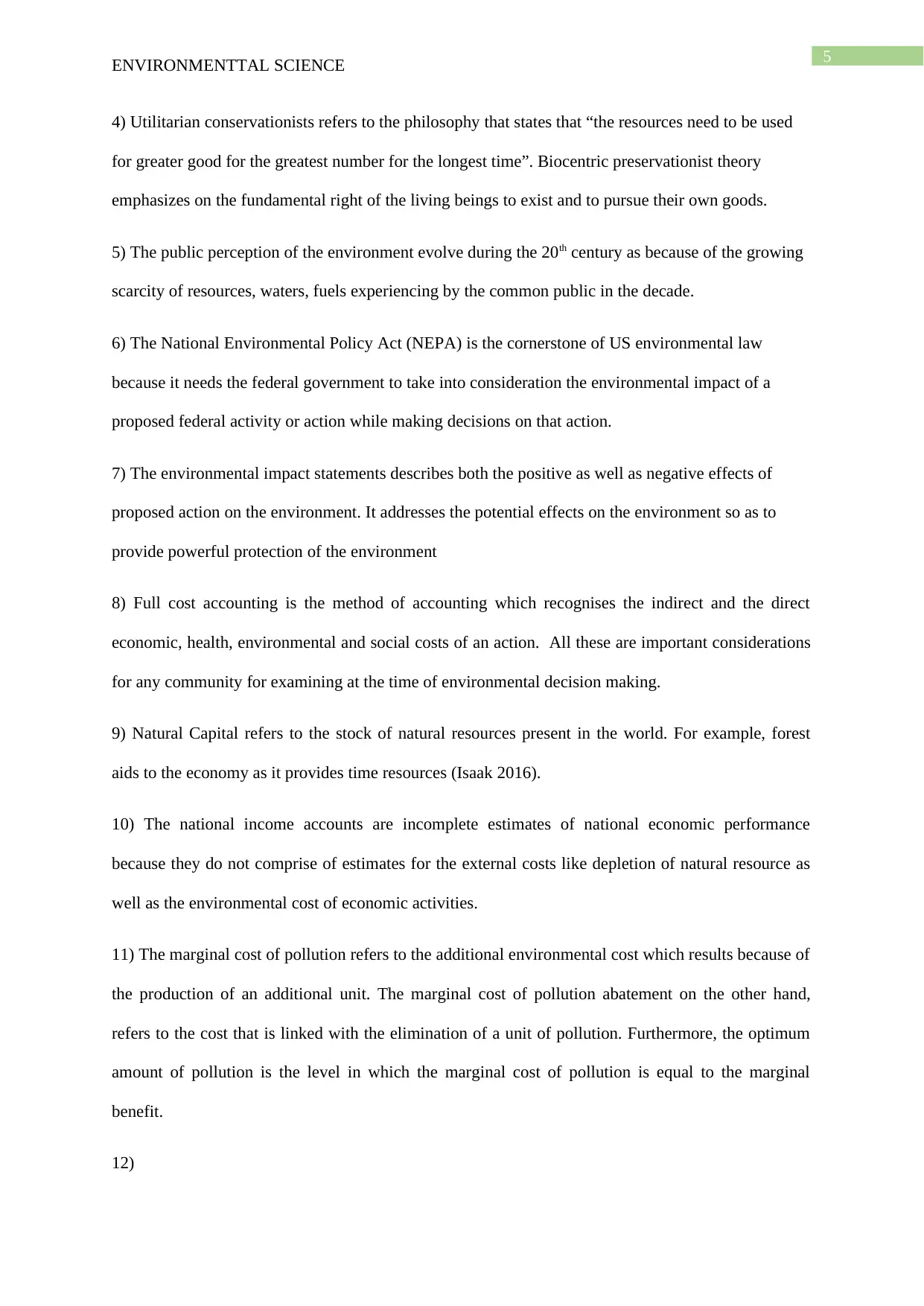
5
ENVIRONMENTTAL SCIENCE
4) Utilitarian conservationists refers to the philosophy that states that “the resources need to be used
for greater good for the greatest number for the longest time”. Biocentric preservationist theory
emphasizes on the fundamental right of the living beings to exist and to pursue their own goods.
5) The public perception of the environment evolve during the 20th century as because of the growing
scarcity of resources, waters, fuels experiencing by the common public in the decade.
6) The National Environmental Policy Act (NEPA) is the cornerstone of US environmental law
because it needs the federal government to take into consideration the environmental impact of a
proposed federal activity or action while making decisions on that action.
7) The environmental impact statements describes both the positive as well as negative effects of
proposed action on the environment. It addresses the potential effects on the environment so as to
provide powerful protection of the environment
8) Full cost accounting is the method of accounting which recognises the indirect and the direct
economic, health, environmental and social costs of an action. All these are important considerations
for any community for examining at the time of environmental decision making.
9) Natural Capital refers to the stock of natural resources present in the world. For example, forest
aids to the economy as it provides time resources (Isaak 2016).
10) The national income accounts are incomplete estimates of national economic performance
because they do not comprise of estimates for the external costs like depletion of natural resource as
well as the environmental cost of economic activities.
11) The marginal cost of pollution refers to the additional environmental cost which results because of
the production of an additional unit. The marginal cost of pollution abatement on the other hand,
refers to the cost that is linked with the elimination of a unit of pollution. Furthermore, the optimum
amount of pollution is the level in which the marginal cost of pollution is equal to the marginal
benefit.
12)
ENVIRONMENTTAL SCIENCE
4) Utilitarian conservationists refers to the philosophy that states that “the resources need to be used
for greater good for the greatest number for the longest time”. Biocentric preservationist theory
emphasizes on the fundamental right of the living beings to exist and to pursue their own goods.
5) The public perception of the environment evolve during the 20th century as because of the growing
scarcity of resources, waters, fuels experiencing by the common public in the decade.
6) The National Environmental Policy Act (NEPA) is the cornerstone of US environmental law
because it needs the federal government to take into consideration the environmental impact of a
proposed federal activity or action while making decisions on that action.
7) The environmental impact statements describes both the positive as well as negative effects of
proposed action on the environment. It addresses the potential effects on the environment so as to
provide powerful protection of the environment
8) Full cost accounting is the method of accounting which recognises the indirect and the direct
economic, health, environmental and social costs of an action. All these are important considerations
for any community for examining at the time of environmental decision making.
9) Natural Capital refers to the stock of natural resources present in the world. For example, forest
aids to the economy as it provides time resources (Isaak 2016).
10) The national income accounts are incomplete estimates of national economic performance
because they do not comprise of estimates for the external costs like depletion of natural resource as
well as the environmental cost of economic activities.
11) The marginal cost of pollution refers to the additional environmental cost which results because of
the production of an additional unit. The marginal cost of pollution abatement on the other hand,
refers to the cost that is linked with the elimination of a unit of pollution. Furthermore, the optimum
amount of pollution is the level in which the marginal cost of pollution is equal to the marginal
benefit.
12)
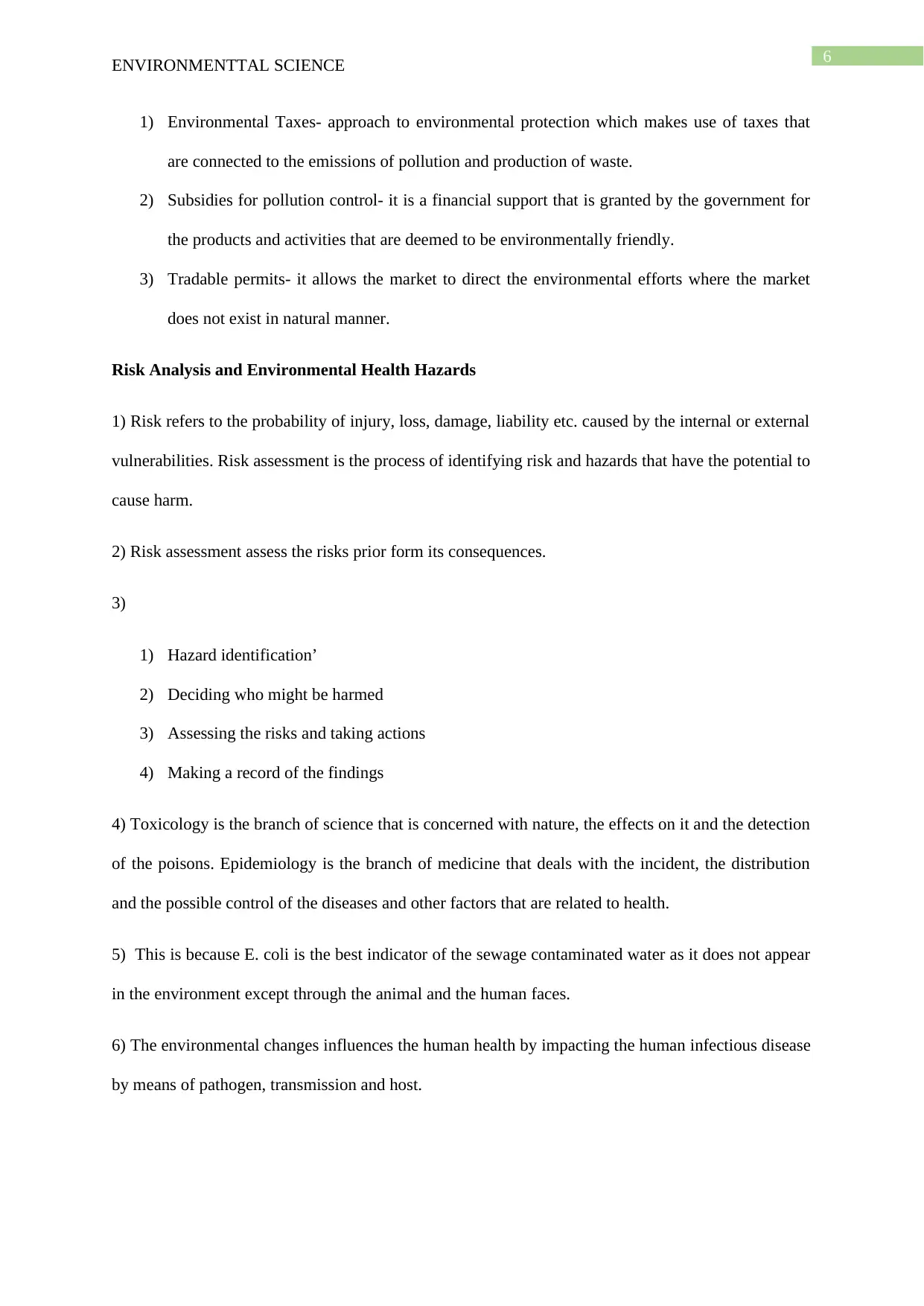
6
ENVIRONMENTTAL SCIENCE
1) Environmental Taxes- approach to environmental protection which makes use of taxes that
are connected to the emissions of pollution and production of waste.
2) Subsidies for pollution control- it is a financial support that is granted by the government for
the products and activities that are deemed to be environmentally friendly.
3) Tradable permits- it allows the market to direct the environmental efforts where the market
does not exist in natural manner.
Risk Analysis and Environmental Health Hazards
1) Risk refers to the probability of injury, loss, damage, liability etc. caused by the internal or external
vulnerabilities. Risk assessment is the process of identifying risk and hazards that have the potential to
cause harm.
2) Risk assessment assess the risks prior form its consequences.
3)
1) Hazard identification’
2) Deciding who might be harmed
3) Assessing the risks and taking actions
4) Making a record of the findings
4) Toxicology is the branch of science that is concerned with nature, the effects on it and the detection
of the poisons. Epidemiology is the branch of medicine that deals with the incident, the distribution
and the possible control of the diseases and other factors that are related to health.
5) This is because E. coli is the best indicator of the sewage contaminated water as it does not appear
in the environment except through the animal and the human faces.
6) The environmental changes influences the human health by impacting the human infectious disease
by means of pathogen, transmission and host.
ENVIRONMENTTAL SCIENCE
1) Environmental Taxes- approach to environmental protection which makes use of taxes that
are connected to the emissions of pollution and production of waste.
2) Subsidies for pollution control- it is a financial support that is granted by the government for
the products and activities that are deemed to be environmentally friendly.
3) Tradable permits- it allows the market to direct the environmental efforts where the market
does not exist in natural manner.
Risk Analysis and Environmental Health Hazards
1) Risk refers to the probability of injury, loss, damage, liability etc. caused by the internal or external
vulnerabilities. Risk assessment is the process of identifying risk and hazards that have the potential to
cause harm.
2) Risk assessment assess the risks prior form its consequences.
3)
1) Hazard identification’
2) Deciding who might be harmed
3) Assessing the risks and taking actions
4) Making a record of the findings
4) Toxicology is the branch of science that is concerned with nature, the effects on it and the detection
of the poisons. Epidemiology is the branch of medicine that deals with the incident, the distribution
and the possible control of the diseases and other factors that are related to health.
5) This is because E. coli is the best indicator of the sewage contaminated water as it does not appear
in the environment except through the animal and the human faces.
6) The environmental changes influences the human health by impacting the human infectious disease
by means of pathogen, transmission and host.
Paraphrase This Document
Need a fresh take? Get an instant paraphrase of this document with our AI Paraphraser
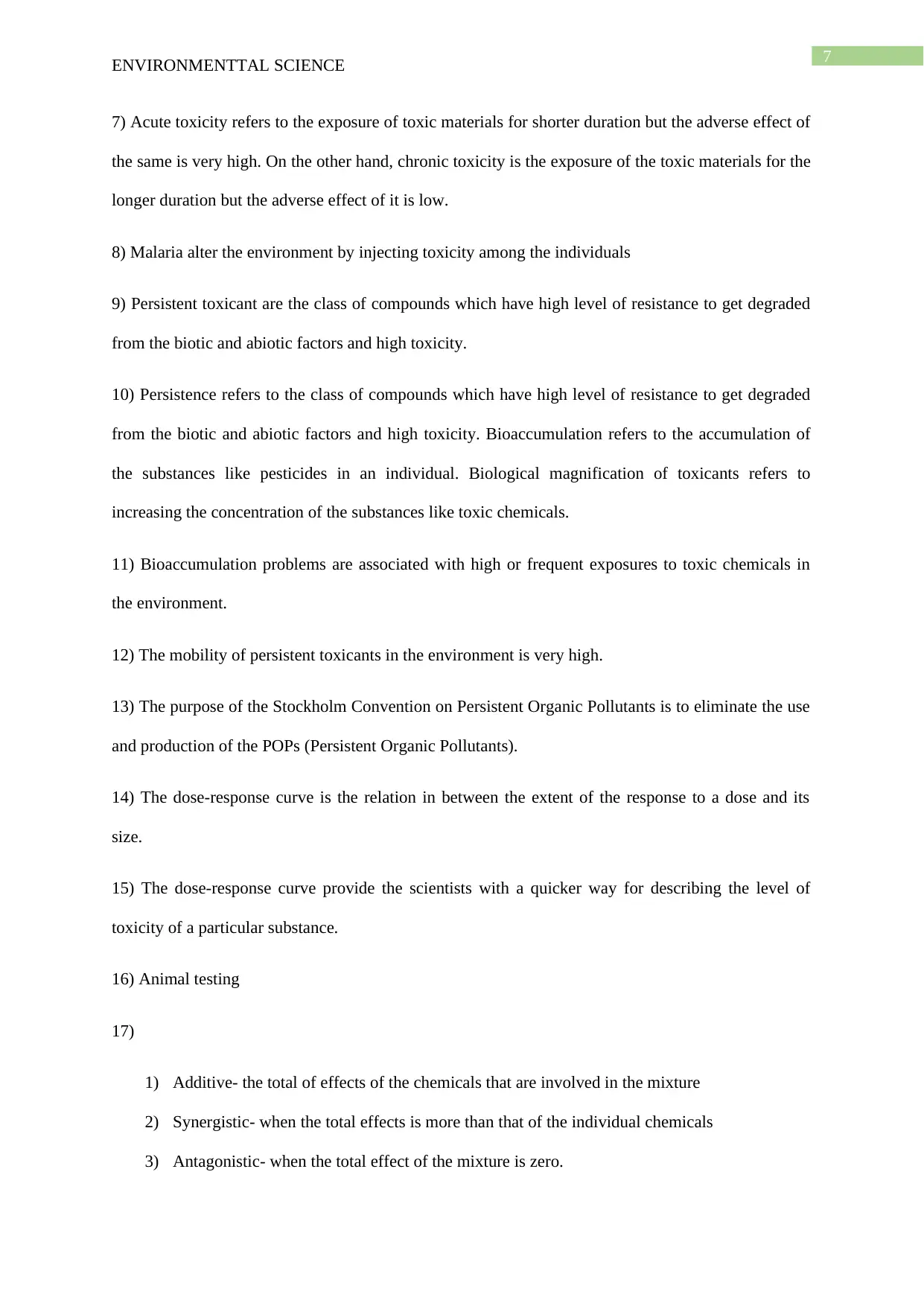
7
ENVIRONMENTTAL SCIENCE
7) Acute toxicity refers to the exposure of toxic materials for shorter duration but the adverse effect of
the same is very high. On the other hand, chronic toxicity is the exposure of the toxic materials for the
longer duration but the adverse effect of it is low.
8) Malaria alter the environment by injecting toxicity among the individuals
9) Persistent toxicant are the class of compounds which have high level of resistance to get degraded
from the biotic and abiotic factors and high toxicity.
10) Persistence refers to the class of compounds which have high level of resistance to get degraded
from the biotic and abiotic factors and high toxicity. Bioaccumulation refers to the accumulation of
the substances like pesticides in an individual. Biological magnification of toxicants refers to
increasing the concentration of the substances like toxic chemicals.
11) Bioaccumulation problems are associated with high or frequent exposures to toxic chemicals in
the environment.
12) The mobility of persistent toxicants in the environment is very high.
13) The purpose of the Stockholm Convention on Persistent Organic Pollutants is to eliminate the use
and production of the POPs (Persistent Organic Pollutants).
14) The dose-response curve is the relation in between the extent of the response to a dose and its
size.
15) The dose-response curve provide the scientists with a quicker way for describing the level of
toxicity of a particular substance.
16) Animal testing
17)
1) Additive- the total of effects of the chemicals that are involved in the mixture
2) Synergistic- when the total effects is more than that of the individual chemicals
3) Antagonistic- when the total effect of the mixture is zero.
ENVIRONMENTTAL SCIENCE
7) Acute toxicity refers to the exposure of toxic materials for shorter duration but the adverse effect of
the same is very high. On the other hand, chronic toxicity is the exposure of the toxic materials for the
longer duration but the adverse effect of it is low.
8) Malaria alter the environment by injecting toxicity among the individuals
9) Persistent toxicant are the class of compounds which have high level of resistance to get degraded
from the biotic and abiotic factors and high toxicity.
10) Persistence refers to the class of compounds which have high level of resistance to get degraded
from the biotic and abiotic factors and high toxicity. Bioaccumulation refers to the accumulation of
the substances like pesticides in an individual. Biological magnification of toxicants refers to
increasing the concentration of the substances like toxic chemicals.
11) Bioaccumulation problems are associated with high or frequent exposures to toxic chemicals in
the environment.
12) The mobility of persistent toxicants in the environment is very high.
13) The purpose of the Stockholm Convention on Persistent Organic Pollutants is to eliminate the use
and production of the POPs (Persistent Organic Pollutants).
14) The dose-response curve is the relation in between the extent of the response to a dose and its
size.
15) The dose-response curve provide the scientists with a quicker way for describing the level of
toxicity of a particular substance.
16) Animal testing
17)
1) Additive- the total of effects of the chemicals that are involved in the mixture
2) Synergistic- when the total effects is more than that of the individual chemicals
3) Antagonistic- when the total effect of the mixture is zero.
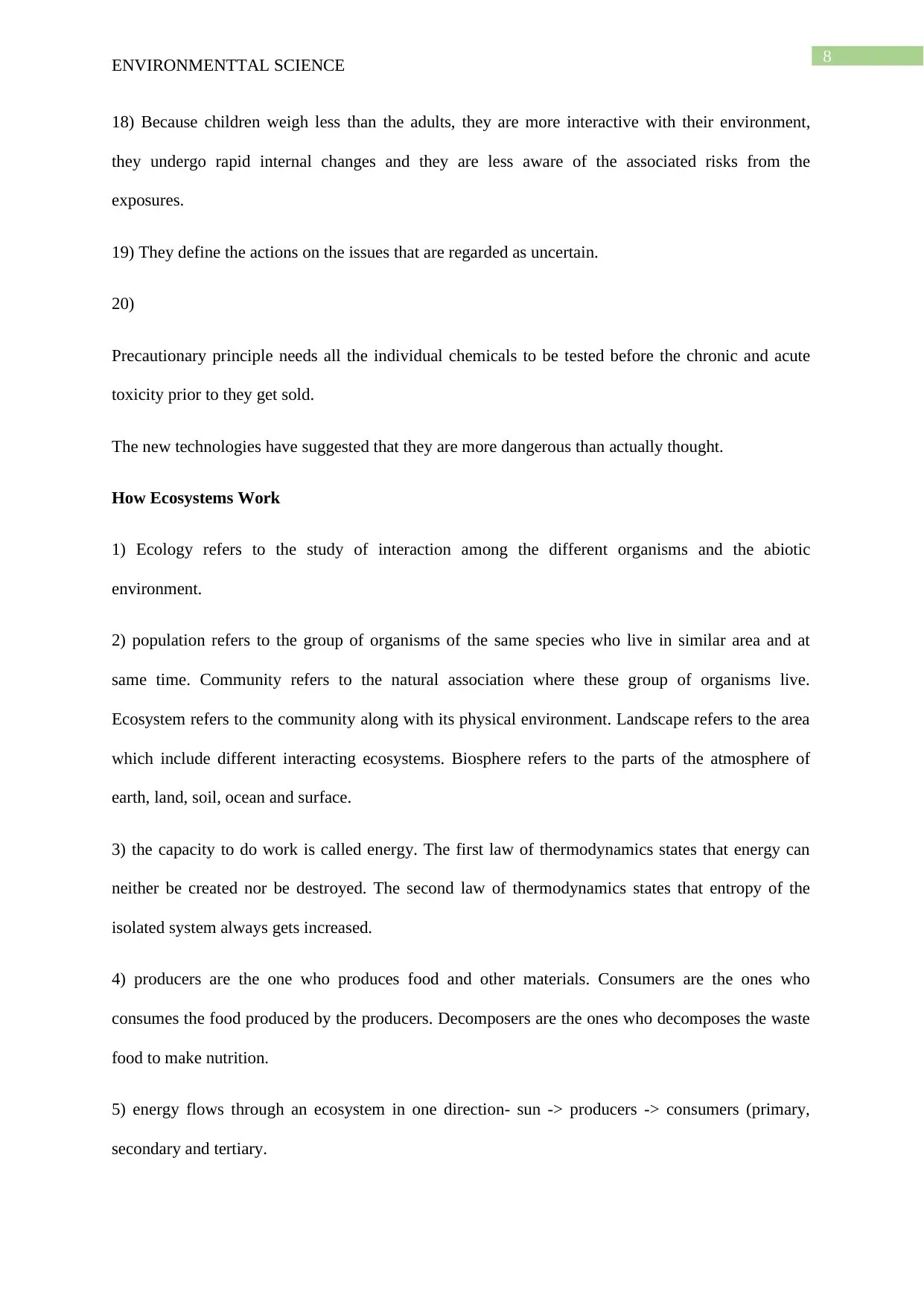
8
ENVIRONMENTTAL SCIENCE
18) Because children weigh less than the adults, they are more interactive with their environment,
they undergo rapid internal changes and they are less aware of the associated risks from the
exposures.
19) They define the actions on the issues that are regarded as uncertain.
20)
Precautionary principle needs all the individual chemicals to be tested before the chronic and acute
toxicity prior to they get sold.
The new technologies have suggested that they are more dangerous than actually thought.
How Ecosystems Work
1) Ecology refers to the study of interaction among the different organisms and the abiotic
environment.
2) population refers to the group of organisms of the same species who live in similar area and at
same time. Community refers to the natural association where these group of organisms live.
Ecosystem refers to the community along with its physical environment. Landscape refers to the area
which include different interacting ecosystems. Biosphere refers to the parts of the atmosphere of
earth, land, soil, ocean and surface.
3) the capacity to do work is called energy. The first law of thermodynamics states that energy can
neither be created nor be destroyed. The second law of thermodynamics states that entropy of the
isolated system always gets increased.
4) producers are the one who produces food and other materials. Consumers are the ones who
consumes the food produced by the producers. Decomposers are the ones who decomposes the waste
food to make nutrition.
5) energy flows through an ecosystem in one direction- sun -> producers -> consumers (primary,
secondary and tertiary.
ENVIRONMENTTAL SCIENCE
18) Because children weigh less than the adults, they are more interactive with their environment,
they undergo rapid internal changes and they are less aware of the associated risks from the
exposures.
19) They define the actions on the issues that are regarded as uncertain.
20)
Precautionary principle needs all the individual chemicals to be tested before the chronic and acute
toxicity prior to they get sold.
The new technologies have suggested that they are more dangerous than actually thought.
How Ecosystems Work
1) Ecology refers to the study of interaction among the different organisms and the abiotic
environment.
2) population refers to the group of organisms of the same species who live in similar area and at
same time. Community refers to the natural association where these group of organisms live.
Ecosystem refers to the community along with its physical environment. Landscape refers to the area
which include different interacting ecosystems. Biosphere refers to the parts of the atmosphere of
earth, land, soil, ocean and surface.
3) the capacity to do work is called energy. The first law of thermodynamics states that energy can
neither be created nor be destroyed. The second law of thermodynamics states that entropy of the
isolated system always gets increased.
4) producers are the one who produces food and other materials. Consumers are the ones who
consumes the food produced by the producers. Decomposers are the ones who decomposes the waste
food to make nutrition.
5) energy flows through an ecosystem in one direction- sun -> producers -> consumers (primary,
secondary and tertiary.
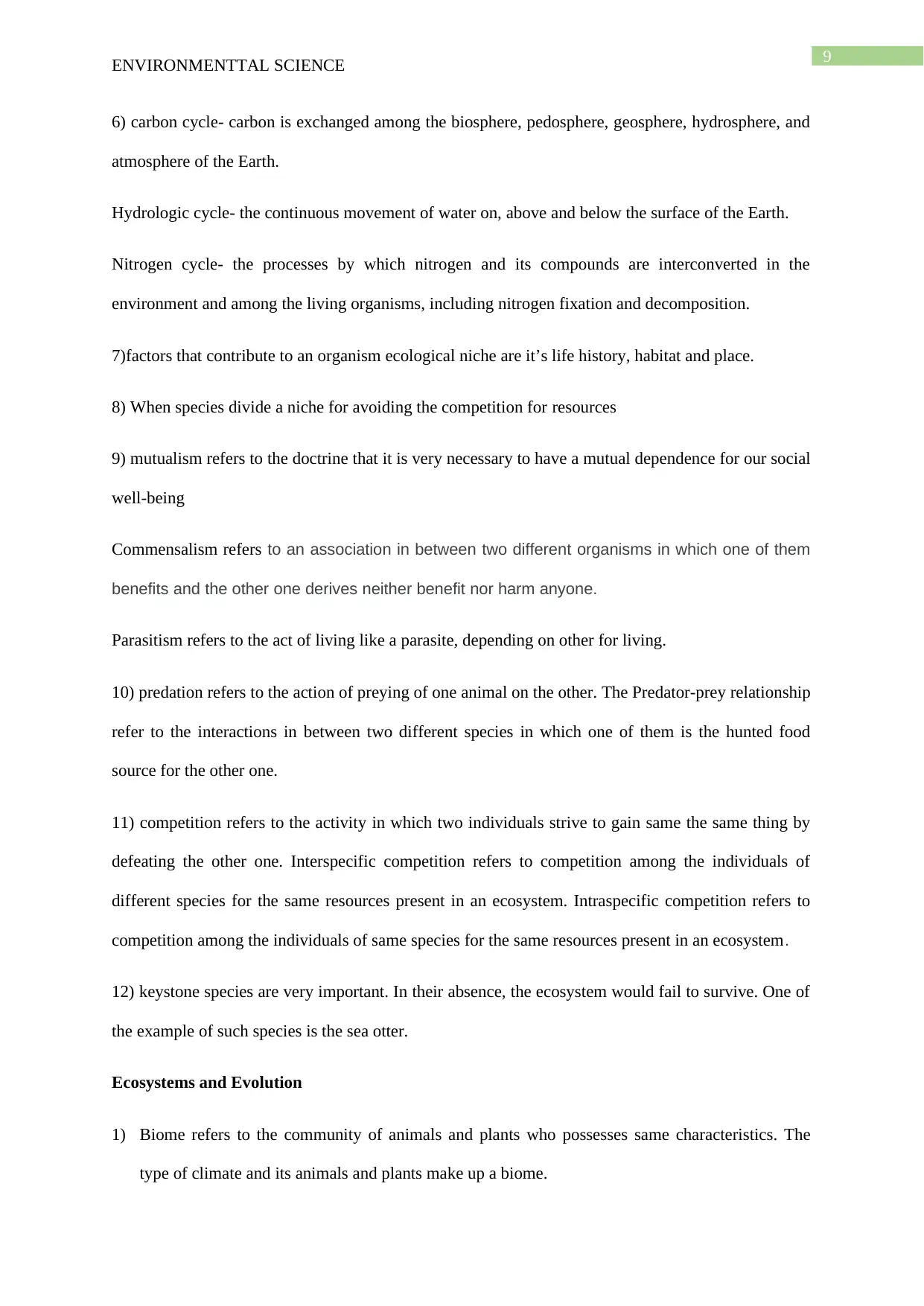
9
ENVIRONMENTTAL SCIENCE
6) carbon cycle- carbon is exchanged among the biosphere, pedosphere, geosphere, hydrosphere, and
atmosphere of the Earth.
Hydrologic cycle- the continuous movement of water on, above and below the surface of the Earth.
Nitrogen cycle- the processes by which nitrogen and its compounds are interconverted in the
environment and among the living organisms, including nitrogen fixation and decomposition.
7)factors that contribute to an organism ecological niche are it’s life history, habitat and place.
8) When species divide a niche for avoiding the competition for resources
9) mutualism refers to the doctrine that it is very necessary to have a mutual dependence for our social
well-being
Commensalism refers to an association in between two different organisms in which one of them
benefits and the other one derives neither benefit nor harm anyone.
Parasitism refers to the act of living like a parasite, depending on other for living.
10) predation refers to the action of preying of one animal on the other. The Predator-prey relationship
refer to the interactions in between two different species in which one of them is the hunted food
source for the other one.
11) competition refers to the activity in which two individuals strive to gain same the same thing by
defeating the other one. Interspecific competition refers to competition among the individuals of
different species for the same resources present in an ecosystem. Intraspecific competition refers to
competition among the individuals of same species for the same resources present in an ecosystem.
12) keystone species are very important. In their absence, the ecosystem would fail to survive. One of
the example of such species is the sea otter.
Ecosystems and Evolution
1) Biome refers to the community of animals and plants who possesses same characteristics. The
type of climate and its animals and plants make up a biome.
ENVIRONMENTTAL SCIENCE
6) carbon cycle- carbon is exchanged among the biosphere, pedosphere, geosphere, hydrosphere, and
atmosphere of the Earth.
Hydrologic cycle- the continuous movement of water on, above and below the surface of the Earth.
Nitrogen cycle- the processes by which nitrogen and its compounds are interconverted in the
environment and among the living organisms, including nitrogen fixation and decomposition.
7)factors that contribute to an organism ecological niche are it’s life history, habitat and place.
8) When species divide a niche for avoiding the competition for resources
9) mutualism refers to the doctrine that it is very necessary to have a mutual dependence for our social
well-being
Commensalism refers to an association in between two different organisms in which one of them
benefits and the other one derives neither benefit nor harm anyone.
Parasitism refers to the act of living like a parasite, depending on other for living.
10) predation refers to the action of preying of one animal on the other. The Predator-prey relationship
refer to the interactions in between two different species in which one of them is the hunted food
source for the other one.
11) competition refers to the activity in which two individuals strive to gain same the same thing by
defeating the other one. Interspecific competition refers to competition among the individuals of
different species for the same resources present in an ecosystem. Intraspecific competition refers to
competition among the individuals of same species for the same resources present in an ecosystem.
12) keystone species are very important. In their absence, the ecosystem would fail to survive. One of
the example of such species is the sea otter.
Ecosystems and Evolution
1) Biome refers to the community of animals and plants who possesses same characteristics. The
type of climate and its animals and plants make up a biome.
Secure Best Marks with AI Grader
Need help grading? Try our AI Grader for instant feedback on your assignments.
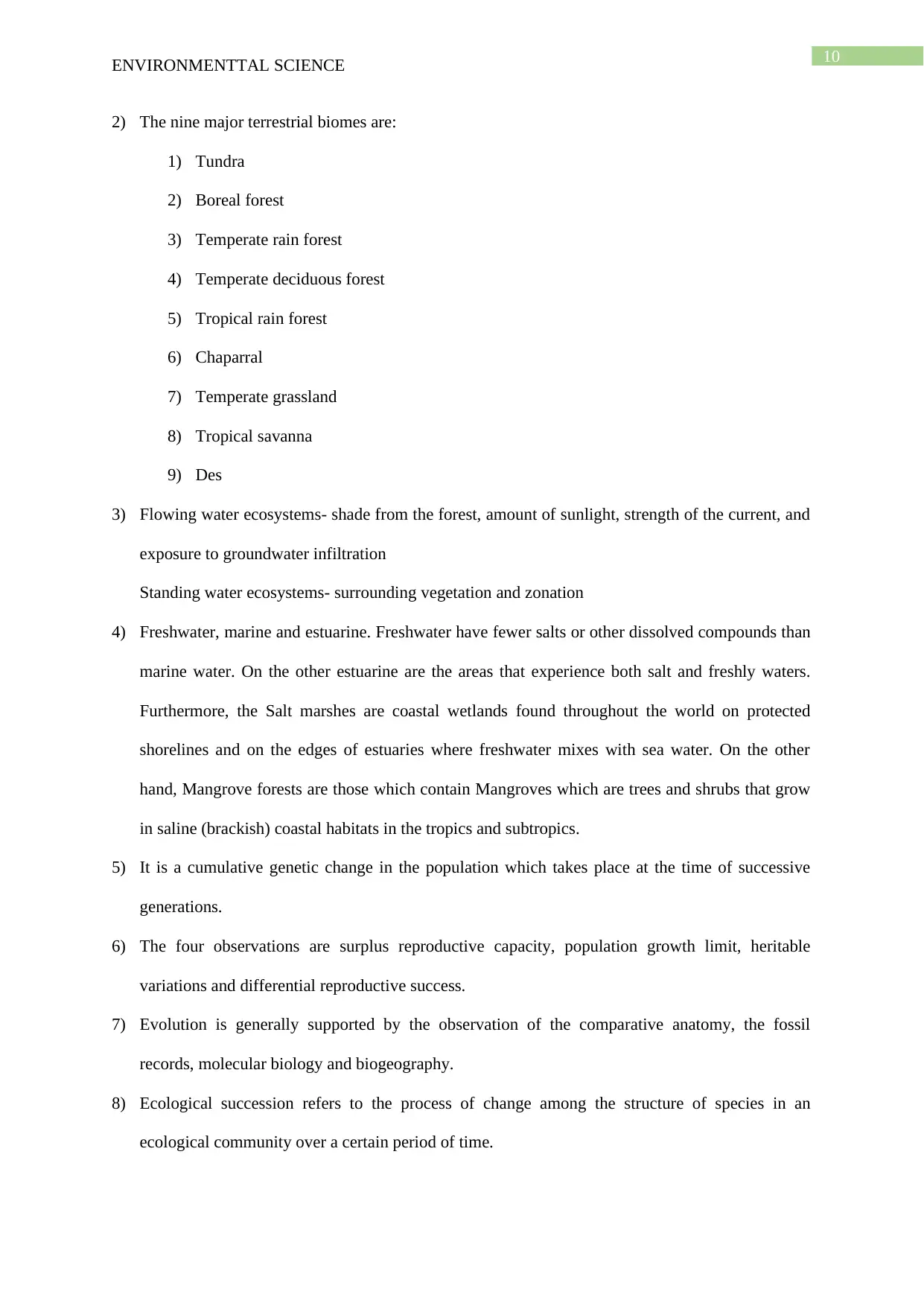
10
ENVIRONMENTTAL SCIENCE
2) The nine major terrestrial biomes are:
1) Tundra
2) Boreal forest
3) Temperate rain forest
4) Temperate deciduous forest
5) Tropical rain forest
6) Chaparral
7) Temperate grassland
8) Tropical savanna
9) Des
3) Flowing water ecosystems- shade from the forest, amount of sunlight, strength of the current, and
exposure to groundwater infiltration
Standing water ecosystems- surrounding vegetation and zonation
4) Freshwater, marine and estuarine. Freshwater have fewer salts or other dissolved compounds than
marine water. On the other estuarine are the areas that experience both salt and freshly waters.
Furthermore, the Salt marshes are coastal wetlands found throughout the world on protected
shorelines and on the edges of estuaries where freshwater mixes with sea water. On the other
hand, Mangrove forests are those which contain Mangroves which are trees and shrubs that grow
in saline (brackish) coastal habitats in the tropics and subtropics.
5) It is a cumulative genetic change in the population which takes place at the time of successive
generations.
6) The four observations are surplus reproductive capacity, population growth limit, heritable
variations and differential reproductive success.
7) Evolution is generally supported by the observation of the comparative anatomy, the fossil
records, molecular biology and biogeography.
8) Ecological succession refers to the process of change among the structure of species in an
ecological community over a certain period of time.
ENVIRONMENTTAL SCIENCE
2) The nine major terrestrial biomes are:
1) Tundra
2) Boreal forest
3) Temperate rain forest
4) Temperate deciduous forest
5) Tropical rain forest
6) Chaparral
7) Temperate grassland
8) Tropical savanna
9) Des
3) Flowing water ecosystems- shade from the forest, amount of sunlight, strength of the current, and
exposure to groundwater infiltration
Standing water ecosystems- surrounding vegetation and zonation
4) Freshwater, marine and estuarine. Freshwater have fewer salts or other dissolved compounds than
marine water. On the other estuarine are the areas that experience both salt and freshly waters.
Furthermore, the Salt marshes are coastal wetlands found throughout the world on protected
shorelines and on the edges of estuaries where freshwater mixes with sea water. On the other
hand, Mangrove forests are those which contain Mangroves which are trees and shrubs that grow
in saline (brackish) coastal habitats in the tropics and subtropics.
5) It is a cumulative genetic change in the population which takes place at the time of successive
generations.
6) The four observations are surplus reproductive capacity, population growth limit, heritable
variations and differential reproductive success.
7) Evolution is generally supported by the observation of the comparative anatomy, the fossil
records, molecular biology and biogeography.
8) Ecological succession refers to the process of change among the structure of species in an
ecological community over a certain period of time.
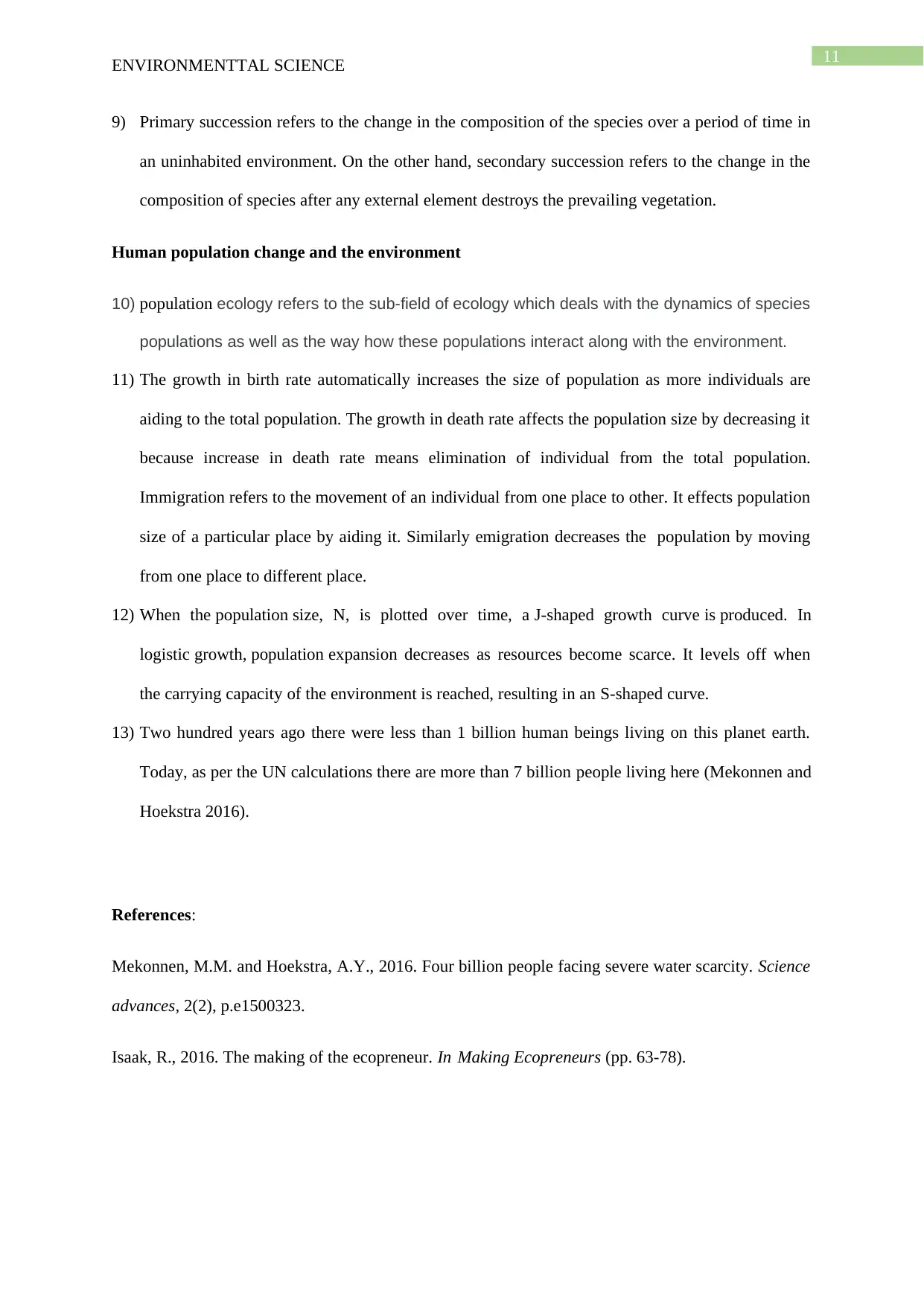
11
ENVIRONMENTTAL SCIENCE
9) Primary succession refers to the change in the composition of the species over a period of time in
an uninhabited environment. On the other hand, secondary succession refers to the change in the
composition of species after any external element destroys the prevailing vegetation.
Human population change and the environment
10) population ecology refers to the sub-field of ecology which deals with the dynamics of species
populations as well as the way how these populations interact along with the environment.
11) The growth in birth rate automatically increases the size of population as more individuals are
aiding to the total population. The growth in death rate affects the population size by decreasing it
because increase in death rate means elimination of individual from the total population.
Immigration refers to the movement of an individual from one place to other. It effects population
size of a particular place by aiding it. Similarly emigration decreases the population by moving
from one place to different place.
12) When the population size, N, is plotted over time, a J-shaped growth curve is produced. In
logistic growth, population expansion decreases as resources become scarce. It levels off when
the carrying capacity of the environment is reached, resulting in an S-shaped curve.
13) Two hundred years ago there were less than 1 billion human beings living on this planet earth.
Today, as per the UN calculations there are more than 7 billion people living here (Mekonnen and
Hoekstra 2016).
References:
Mekonnen, M.M. and Hoekstra, A.Y., 2016. Four billion people facing severe water scarcity. Science
advances, 2(2), p.e1500323.
Isaak, R., 2016. The making of the ecopreneur. In Making Ecopreneurs (pp. 63-78).
ENVIRONMENTTAL SCIENCE
9) Primary succession refers to the change in the composition of the species over a period of time in
an uninhabited environment. On the other hand, secondary succession refers to the change in the
composition of species after any external element destroys the prevailing vegetation.
Human population change and the environment
10) population ecology refers to the sub-field of ecology which deals with the dynamics of species
populations as well as the way how these populations interact along with the environment.
11) The growth in birth rate automatically increases the size of population as more individuals are
aiding to the total population. The growth in death rate affects the population size by decreasing it
because increase in death rate means elimination of individual from the total population.
Immigration refers to the movement of an individual from one place to other. It effects population
size of a particular place by aiding it. Similarly emigration decreases the population by moving
from one place to different place.
12) When the population size, N, is plotted over time, a J-shaped growth curve is produced. In
logistic growth, population expansion decreases as resources become scarce. It levels off when
the carrying capacity of the environment is reached, resulting in an S-shaped curve.
13) Two hundred years ago there were less than 1 billion human beings living on this planet earth.
Today, as per the UN calculations there are more than 7 billion people living here (Mekonnen and
Hoekstra 2016).
References:
Mekonnen, M.M. and Hoekstra, A.Y., 2016. Four billion people facing severe water scarcity. Science
advances, 2(2), p.e1500323.
Isaak, R., 2016. The making of the ecopreneur. In Making Ecopreneurs (pp. 63-78).
1 out of 12
Related Documents
Your All-in-One AI-Powered Toolkit for Academic Success.
+13062052269
info@desklib.com
Available 24*7 on WhatsApp / Email
![[object Object]](/_next/static/media/star-bottom.7253800d.svg)
Unlock your academic potential
© 2024 | Zucol Services PVT LTD | All rights reserved.





